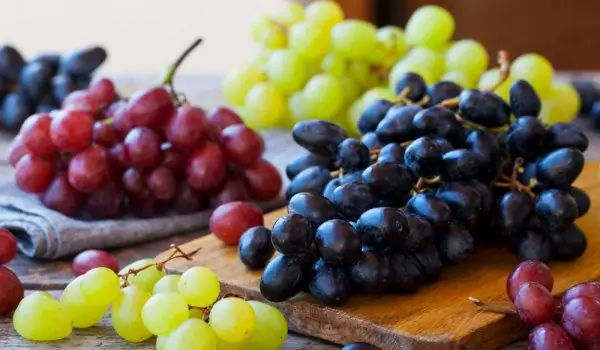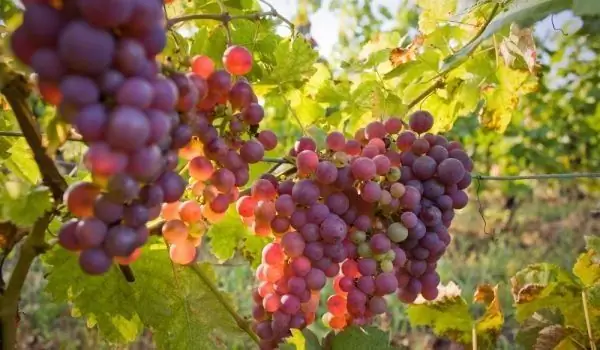2025 Author: Jasmine Walkman | [email protected]. Last modified: 2025-01-23 10:18
Jabotikaba / Myrciaria cauliflora /, also known as Myrciaria cauliflora, is an evergreen slow-growing tree that originates from southern Brazil. It is also known as Brazilian grape tree or Brazilian grape, due to its great resemblance to grapes. Jabotikabata is widespread in many tropical regions of the world. It has a round compact bark, which is covered with small lanceolate petals. The tree reaches a height of 12 meters, but only in its homeland. When grown in plantations around the world it grows up to 3-5 meters.
The leaves of jaboticaba are characterized by a pleasant laurel aroma. The trunk and branches of the tree are covered with light bark, which has a pink tinge and gray spots. In spring and summer, the jabotikaba is covered with many small white flowers with long stamens growing directly on the trunk and main branches.
This phenomenon is known as kaulifloria - the formation of flower buds on the trunk and main branches, but not the final ones - as happens with most fruit trees. This process can be seen in cocoa and some other tropical fruit trees.
Jabotikabata is truly unique in its appearance wood. It yields from spring to autumn, and the fruits ripen in 3-4 weeks. In the beginning the fruits are green, then in the process of ripening they acquire a dark red, and then almost black color. The ripe fruits are very similar to the grapes. They have a stone, which is surrounded by translucent fragrant fruit flesh, which has an extremely sweet taste.
In winter, the tree may lose some of its leaves, but in the spring the rose petals appear, which later acquire their usual dark green color.
Growing jabotikaba

Jabotikabata is a great tree for growing in a container indoors or as a plant in a winter garden. Due to its relatively slow growth, it can be formed as a bonsai. The plant, which is formed as a small tree, looks very decorative - green bark, combined with rose petals, bright stem and twigs, which are covered with many fruits and flowers. The tree attracts many butterflies, bees and birds.
Jaboticaba can grow well in light, well-drained, neutral or very slightly acidic soil mixture. It is best to use a humus-free soil mixture based on coconut fiber or peat. Drainage is completely mandatory. Transplanting should be done as needed, taking into account the growth of the tree.
Jaboticaba likes regular watering, drying or watering the soil has a negative effect. Water the plant when the top layer of soil (1-2 cm) dries. Feed with complex mineral fertilizers. Jabotikabata grows well in partial shade and only a few hours of morning and evening sun.
Composition of jabotikaba
100 g jabotikaba contain 0 g of fat, 1 g of protein, 13 g of carbohydrates, 6 mg of calcium, 0.01 mg of thiamine, 9 mg of phosphorus, 0.6 g of fiber, 22 mg of vitamin C.
Selection and storage of jabotikaba
The fruits of jabotikaba are about 3-4 cm in size. Well-ripened fruits have a purple color, round shape and soft gelatinous core, with 1-4 grains. The fruit is very sweet. In our country it is very rare to find this exotic fruit.
Jabotikaba in cooking

The fruits of jabotikaba are consumed fresh, preferably immediately after harvesting. If they are picked poorly ripened, you can store them for up to several days.
Manner of consumption: squeeze the fruit between your thumb and forefinger and bring it to your mouth. Due to the pressure, the skin is torn and the delicious meat falls directly on the tongue.
The fruits jabotikaba can be used to make delicious jellies and marmalades, as well as ice cream. In Brazil, they are used to make extremely aromatic wine. They are also used for liqueurs. Jaboticaba ice cream has a very exotic taste and is also ideal for the summer months. If you want homemade ice cream with the aroma of this fruit, you need 3 glasses jabotikaba, 2 ¾ cups sugar, 2 liters of milk.
Method of preparation: Peel a squash, grate it and put it in a saucepan. Pour enough water to cover them. Cook until the fruits are completely soft and leave them overnight.
Then boil them once more and leave them in gauze to drain. Add sugar to the resulting juice and stir until completely dissolved. Finally add the milk and slowly freeze.
Benefits of jabotikaba
Jabotikabata is a delicious fruit that is suitable for any diet due to the lack of any fat. Fiber makes it ideal for cleansing the stomach and intestines. Vitamin C in its composition is an excellent antioxidant that protects cells from harmful influences and slows down the aging process. By consuming jaboticaba, the body obtains important vitamins and minerals that are needed to maintain normal, healthy functions.
Recommended:
The Undeniable Benefits Of Grapes

The vine is one of the oldest plantations grown by man. The fruit of the vine - grapes, is tasty and useful. It is used not only for the production of wine and other beverages, but also as a food product and as a medicinal food. Grapes help with digestive problems and constipation, kidney problems, fatigue, eye diseases such as macular degeneration and cataracts.
Grapes

Grapes are the seeds of plants of the genus Vitis, known in Bulgarian as vines. On the botanical side, grapes are considered strawberry fruits. The grapes has small round or oval fruits, with semi-transparent, smooth skin. Some types of grapes contain edible seeds, while others are seedless.
Why Eat Grapes

Grapes are one of the most useful and beloved fruit, especially because of its tart taste, fresh texture, juiciness and attractive color. The good news is that these fruits are full of essential nutrients and are almost like medicine in terms of the various health benefits they provide.
Grapes - The Fruit Of The Gods

The earliest people to appreciate the qualities of grapes were hunters and fruit pickers from the pre-civilization era. Scientists believe that the origin of the grapes originated in the Black Sea region in Eastern Europe and then spread south to the Middle East.
The Rains Also Scalded The Grapes

Heavy rains this week are about to ruin the grape harvest, with local growers saying they don't know how to make up for their huge losses this year. Farmers from the Sandanski region say their plantations have been scorched by the rains, and much of the crop has begun to mold.

